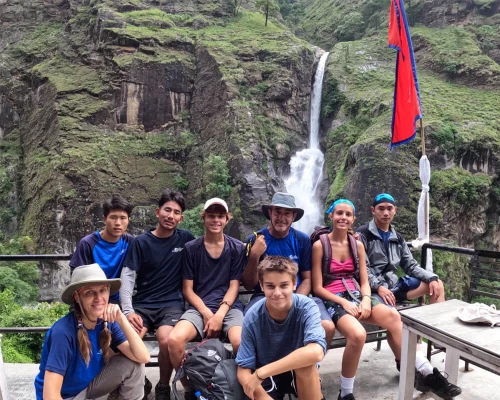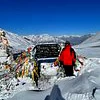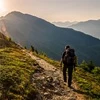Introduction: Annapurna Round Trip
The Annapurna round-trip package is a well-planned and exciting trekking package. This Annapurna Circuit trek takes trekkers to the Annapurna region, located at the lap of the Himalayan region of Nepal. The Annapurna round trip offers an exclusive view of majestic peaks in the Annapurna region. The mountains include Machhapuchhare, Gangapurna, Tilicho Peak, Annapurna II, Annapurna IV, Hiunchuli, Lamjung Himal, Manaslu, and Tukuche Peak.
The Annapurna Round Trip route involves walking through the rhododendron, oak, and alpine forests. Similarly, trekkers can pass through remote settlements, explore the landscapes, and get insights into the cultural way of life of the people living in these regions.
The area around Annapurna Circuit provides a similar experience as trekking to Everest Base Camp. It is an easier and more comfortable trek than traveling in the Everest region; hence, it is regarded as one of the world's top ten destinations for climbing, visiting, and trekking. The snow-capped mountains provide a sense of relaxation, excitement, completeness, and adrenaline while rejuvenating visitors embarking on the Annapurna circuit trek.
The trails are rugged, including steep and narrow paths. Trekkers encounter the Nepalese uphill, flat, and steep descent, challenging every fitness group. The world's deepest gorge, the Kali Gandaki gorge, is also a major highlight on this Annapurna trekking map.
How is a typical day of Annapurna round-trip trekking?
Generally, trekkers begin the Annapurna trek from the capital city, Kathmandu, while waking most of the morning at around 7-8 A.M. However, on certain days, trekkers may have to wake up at about 3–4 a.m, depending upon the destination or purpose of the day.
Embarking with Nature Excursion, we prioritize good food as it is a crucial part of the trek. So, every morning starts with a fulfilling breakfast that will energize trekkers until they reach the lunch stop. The guides ensure that belongings, gear, and types of equipment are not left behind so that no item is lost. However, it is the responsibility of the trekkers to thoroughly check their goods before leaving the accommodation place.
Likewise, porters usually walk ahead of us to carry all your heavy goods. As porters walk ahead, it enables them to reach the next destination early and prepare for resting, including booking the accommodation place, exploring the dinner options, and checking the amenities of the rest spot.
As porters carry most of the goods, this gives us the idea to carry only the most essential items for a particular section of the Annapurna route. This plan will help make your journey in the Annapurna region reliable and relaxing. Also, the lunch spots for a typical day will be predetermined, while accommodation places might have a minimal chance to change in peak season or depending upon the amenities.
As the round Annapurna trip begins from Kathmandu, the trek passes through various settlements and ends with a scenic drive from Pokhara to Kathmandu. Trekkers will have the opportunity to pass through notable locations like Jagat, Dharapani, Chame, Pisang, Manag, Yak Kharka, Thorang Phedii, Annapurna High Camp, Thorang La Pass, Marpha, Lete, Tatopani, Ghorepani, Hile, and finally Pokhara. Each of these locations is in the order of the trekking destinations.
Do you need a guide for the Annapurna Round trip? Can I trek alone?
Trekkers who want to trek to the Annapurna Circuit can do it alone without a guide. However, nature excursions and the team recommend embarking on the trek with an experienced guide. Having a guide on the journey will make the trip safer, more enjoyable, and more meaningful.
First, a guide knows the region, including the trails, people, name of the mountain, and structures. Guides know precisely which part of the section is difficult and when we can reach the destination while calculating your pace. Guides, especially those from Nature Excursions, can easily navigate the routes and trails. Guides tend to keep valuable information about the region's weather conditions, potential hazards, and safety measures, which all help in a hassle-free, safe trekking experience.
Similarly, our guides are from the region, enabling them to bond with the locals. Thus, they become a bridge between visitors and locals through communication, which ultimately helps trekkers learn more about the Himalayan region's local culture, tradition, and way of life.
On the other hand, guides can also assist in handling logistics at the check-post or hotels along the Annapurna route. They can arrange accommodation, obtain necessary permits, manage transportation, and navigate challenging situations while preparing for emergencies.
Is the Annapurna round-trip trip difficult? And what are the chances of altitude sickness?
The Annapurna round trek is moderately to difficult trekking for beginners and experienced trekkers. Regarding physical fitness, it is the right choice for beginners who do not have prior trekking experience but are in good physical condition.
However, the Annapurna round-trip map has some problematic sections, which can be challenging yet fun. Some sections are manageable with flat terrain, but others are more rugged with steep ascents and descents. As the Annapurna region is in the Himalayan region of Nepal, trekkers reach a maximum altitude of 5,416 m (17,769 ft). Frequent weather conditions like sudden temperature changes, heavy snowfall, high-velocity wind, storms, and fog highly influence this high-altitude region.
So, due to these environmental factors, the Annapurna region needs proper planning, and application is required.
Similarly, as mentioned previously, the Annapurna trek lies in the Himalayan region. So, in this 18-day Annapurna round trip, the elevation gradually increases daily. This increase in altitude corresponds with a decrease in oxygen level, resulting in altitude sickness.
Trekkers will gain a maximum of 2,216 m (7,270 ft) during the overall trek, where they can be prone to acute mountain sickness (AMS) or altitude sickness. Staying hydrated and acclimating appropriately to the decreased oxygen level is advised to avoid altitude sickness. Our guides will constantly remind you to drink water and will navigate the whole journey while properly giving time for acclimatization. Similarly, any unusual response from the body must be shared with the guide.
What are the symptoms of Acute Mountain sickness?
The following are some of the early symptoms of altitude sickness: It is advised to study and understand these symptoms and recognize them before any complications:
- Headache
- Nausea and Vomiting
- Shortness of Breath
- Difficulty in sleeping
- Fatigue and Weakness
In severe forms, AMS can result in High Altitude Cerebral Edema (HACE) and high-altitude pulmonary edema (HAPE). If severe symptoms are experienced, it is essential to descend quickly to a lower altitude and seek medical attention.
18-Day Annapurna round-trip trek preparation
The Annapurna round-trek is only possible if proper preparation is done. Individuals willing to embark on this journey must have at least one month of prior experience. In 30 days, it is advised to go on a few hikes and do regular long walks. Avoid the use of lifts and always take stairs.
Similarly, cardio training like swimming, cycling, running, and jogging can help increase trek endurance. Weight training of at least 20–25 kg can also help, as the trekkers may need to carry bags if porters are not hired.
Despite physical fitness, one must also have mental strength. Your mentality is what primarily determines the success of the trip. We suggest fellow trekkers research the area, the type of trails, its present condition, the locals of the region, their culture and tradition, climate and rainfall patterns, types of food options, and available accommodation facilities. This will give you an overview of what to expect while on the trip, thus allowing you to be prepared for any unexpected changes.
What is the Annapurna Trek elevation and altitude profile?
The Annapurna trek begins at Kathmandu, which is at 1400 meters. The starting point of the trek is Jagat (1,920 m/4,232 ft). After Jagat, we moved towards Dharapani; after Dharapani, over six days, we moved towards Yark Kharka. The following day, we will reach the trek's highest point, Thorang Phedi, or High Camp. After Thorang Phedi, the journey moves towards the holy temple of Muktinath. This section is ultimately known to be the successful completion of the Thorang La pass. After Muktinath, we will continue the journey toward Marpha, followed by Lete. After Lete, we rejuvenated at Tatopani (Hot Spring), located at 1,200 m/3,940 ft. Similarly, the follow-back journey continues towards Poon Hill while finally reaching Pokhara to depart for Kathmandu. This marks the end of the trip.
Annapurna region trekking all-inclusive package for 2024/25 spring and autumn
There are several options to choose from in the Annapurna region, depending on personal interest or a customized itinerary. The Annapurna region package for the year 2024/25 during the spring and autumn are: Short Annapurna Circuit with Tilicho Lake Trek, Annapurna Circuit with Tilicho Lake Trek-14 days, Annapurna Circuit Budget Trek, Annapurna Base Camp Short Trek 7 Days, and Annapurna Base Camp with Helicopter Return 9 Days.
Similarly, the Ghorepani Ghandruk Short Trek 4 Days, Annapurna Base Camp Hike 9 Days, Khopra Dadha Trek 12 Days, Poon Hill Short Trek 13 Days and Mardi Himal Trek 9 Days are some other choices of interest for the on season.
What is the alternative Annapurna round-trip trek packages and other adventurous treks in Nepal?
The alternative to the Annapurna round-trip package can be the Everest Base Camp trek. Nature Excursion Pvt. Ltd. can recommend various travel packages that provide a similar trekking experience as the Annapurna round trip. Various trekking routes under various trekking regions are well-known to visitors, including the Everest View Trek 9 days, the 13 Day Gokyo Lake Trek, the Three High Pass Trek 19 days), the Gokyo Chola Pass Trek, and many more.
In the Manaslu and Mustang regions, the alternative trekking options can be the Manaslu Circuit Tsum Valley Trek 19 days or the Upper Mustang trek. Similarly, the trekking package in the Langtang region can be 15 Days Langtang Gosaikunda Helambu Trek, Tamang Heritage Trek 8 Days and Gosaikunda Lake Trekking 8 Days.
All in all, these packages portray the mountain range of the Himalayan region of Nepal with vibrant landscapes. Some of the prominent structures and settlements offer a chance to immerse yourself in the Nepalese way of life, which is a blend of culture, customs, traditions, and religion. Selecting any of the packages is an excellent choice for trekking, which will guarantee a safe, comfortable, and informative experience.
What are the benefits of Annapurna round-trip trekking with Nature Excursion?
- Complimentary airport transportation according to the schedule.
- Obtain hiking equipment for the trip, such as a duffel bag and down jacket, which should be returned after the expedition.
- Using a first-aid kit and an oxygen meter when hiking.
- Local porters and guides for mountains
- Spick and span with well-prepared meals.
- Trek certificate and t-shirt from Nature Excursion.
- During the walk in the remote areas, use the satellite phone to communicate with the office staff.
- In Kathmandu, extra luggage storage is free.
- In an emergency, we will offer you rapid helicopter rescue and medical support (at your travel insurance company's expense).
- Farewell dinner at the end of the hike.


.webp)


.webp)
.webp)






